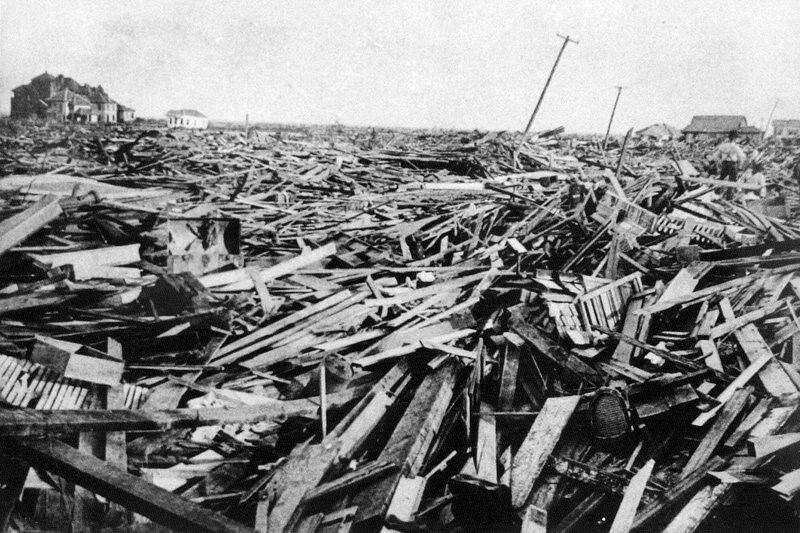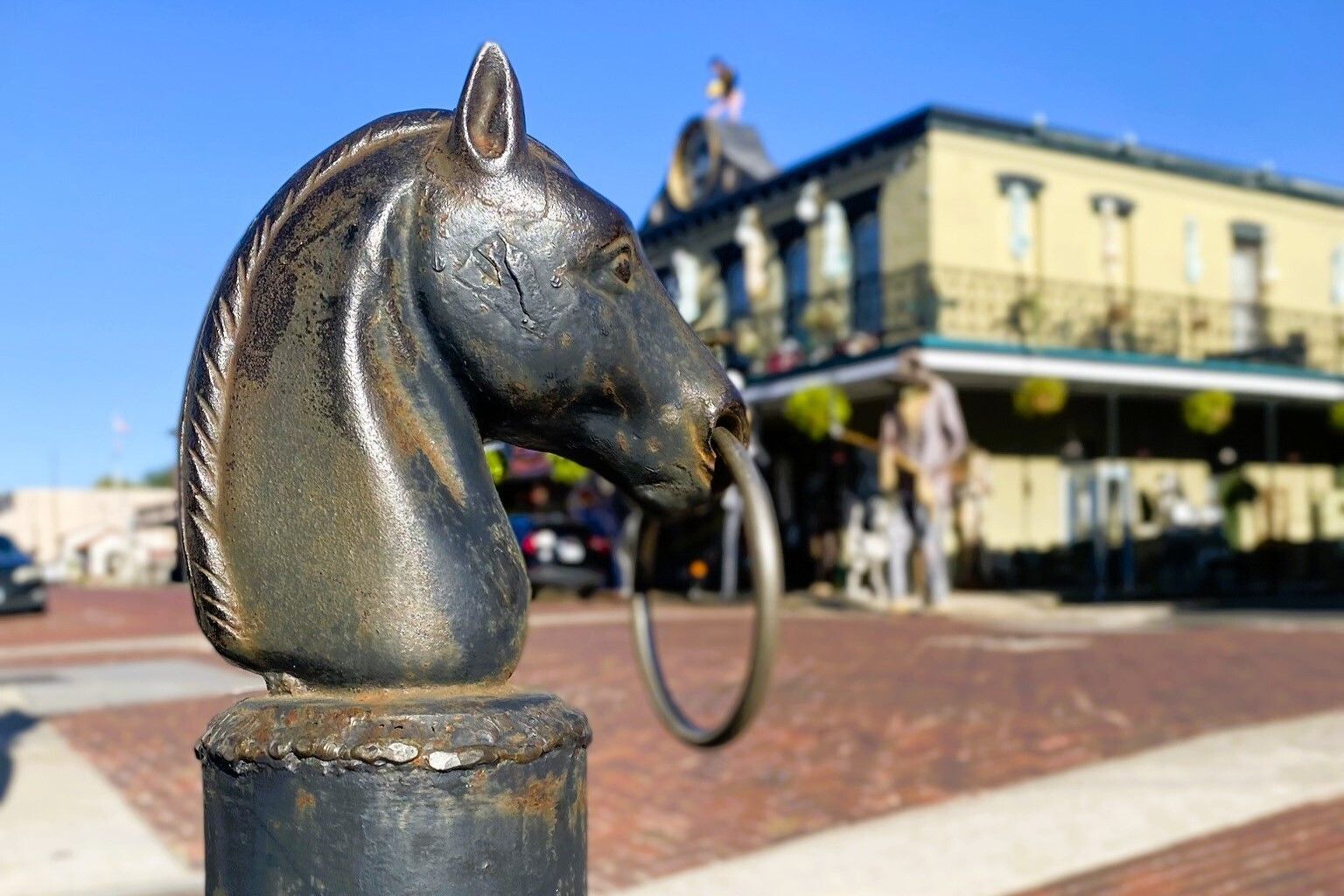
Galveston, Texas, the third-richest city in the United States in 1900, was one of the fastest booming places in the country. It was a prosperous port city full of grandeur, opulence, grace, and charm and had the potential of becoming the greatest city in the South–in other words, the New York of the Gulf. But all Galveston’s hopes and dreams were shattered in one day. That was the day of the Category 4 hurricane of 1900, and it took the city by complete surprise. When the storm had passed it became the deadliest natural disaster in U. S. history.
Galveston is an island off the coast of Texas, about 30 miles long and one-and-one-half to three miles wide. The city of Galveston is located on the east end of the island, and at the time of the hurricane, it was home to about 38,000. The highest elevation on the island was only about eight feet above sea level in 1900. Visitors to Galveston were struck by how flat the city was–so close to sea level that ships in the Gulf produced the illusion that they were sailing on the streets.
September 7, 1900 was a normal summer Galveston Friday: hot, muggy, and dry. Galveston was put under a storm warning by the central office of the U. S. Weather Bureau (USWB), now the National Weather Service. The head of the USWB office in Galveston was Isaac Cline. At that time of year storms are common so Cline was not worried.
In 1892, Cline had written an article in the Galveston News about the local weather stating that a hurricane striking the city was an “absurd delusion.” He said, “It would be impossible for any cyclone to create a storm wave that would materially injure Galveston.” At that time, no one understood hurricanes, but it was soon proved how naive Cline had been. In fact, some wondered if his statement was perhaps local propaganda intended to help the city grow faster than its neighbor, Houston, which was also vying for the position of being the largest port city in the South. At the time only two large storms were known to have struck the Texas coast, both in Matagorda Bay 150 miles to the south of Galveston. The first was in the summer of 1875. That storm pushed an immense dome of water more than 20 miles inland from Indianola with winds estimated in excess of 100 miles an hour. The second storm was in 1886, and it was even more destructive than the first. The residents of Indianola abandoned the town forever.
Following that event, a group of prominent Galveston residents calling themselves the Progressive Association resolved to build a sea wall for the city. Galveston was even more vulnerable to destruction than Indianola because it had no barrier islands and no buffer of prairie between the water and the city. But the idea was shelved. Not long afterwards, Cline wrote his article stating that no storms would hit Galveston and the locals chose to place their faith in him.
On Tuesday September 4, 1900, a storm hit Cuba. As a result of the Spanish- American War the United States still controlled Cuba. Cubans were experts about hurricanes and had more experience predicting them than any American weather forecaster. Willis Moore, then the head of the USWB in Washington, was disdainful of the Cubans. They predicted the storm over their country would head into the Gulf of Mexico, develop into a hurricane since the Gulf waters, were still so warm from the summer, then head for Galveston.
But that information never made it to America, much less to Galveston, because Moore had declared that no Cuban weather predictions were to be sent to the United States. He felt that American forecasters were more scientific than the Cubans so only they could send weather reports to the United States. Unfortunately, those reports were that the storm would head east to Florida and then travel up the East Coast.
But the Americans were wrong. The storm did travel north east to the Florida Keys, but then it unpredictably changed course and headed straight towards Galveston gaining strength and becoming a monster. Willis Moore was so determined to downplay the Cuban expertise that he went so far as to refuse anyone in the Weather Bureau from calling the storm a hurricane unless Moore himself authorized it. The signs were certainly there warning of the ferocity of the storm, but they were ignored because of ego.
Back in Galveston, Isaac Cline went to the beach on the morning of September 7 to make his daily weather observations. He noticed that the tide had risen above normal, incoming swells were appearing, and the wind was coming from the north, which was very unusual. Normally the direction of the wind would be pushing the larger swells away from shore, but Cline witnessed the opposite. However, he had written the article stating that a hurricane in Galveston was impossible, and he believed it. That was his downfall. He was full of confidence and stubbornness and he failed to acknowledge the signs.
Joseph Cline, Isaac’s younger brother, was also working for the USWB on Galveston. He noticed the same signals and drew a quite different conclusion. He began to believe that a storm was coming, and he went to Isaac with his suspicions. He was dismissed. People at the turn of the century were unaware of storm surge believing that the worst damage from a hurricane came from the wind. Galveston was about to learn a painful lesson.
September 8 started out with a brisk wind. Cline once again noticed the high swells on the water. Had he received the forecast information from Cuba, the weatherman might have paid more attention to the signs and raised a warning. By mid-morning it started to rain, and the wind picked up. When Isaac got to work, he saw that the barometer was falling. At nine in the morning, unbeknownst to Isaac, the storm was 50 miles off the coast of Galveston. Ships on the water were aware that something was coming, but they had no means of contacting anyone on shore to warn them.
The residents of Galveston were unconcerned with the high tides since that happened often. A feeling of complete normalcy pervaded the island. By late morning, Avenue B (more commonly known as the Strand, The Wall Street of the West) was flooding with more than two feet of water. Downtown streets were paved and walled with knee-high curbs just as they are now. It was common for the streets to flood, so the curbs were there to keep water off the sidewalks. The residents of Galveston trusted their weather office and thought no more about the situation. Children were playing in the flooding streets riding on homemade rafts.
People headed to the beach to watch the waves roll in. It was all great fun until the giant bathhouses along the beach started to break apart. These giant structures were built on huge timbers and had been there for many years. But now boards were flying through the air, and pieces of the bathhouses fell into the sea. By 2:30 p.m. water filled up the city as the bay to the north had been pushed onto the island.
Isaac Cline finally realized that his brother was right. There was indeed a hurricane in the Gulf, but the hurricane flags were never raised since Moore still had not allowed the storm to be called a hurricane. It was too late anyway. Trains could no longer get into or out of the city. Horses and wagons could no longer pass. People were trapped.
Islanders started gathering in the larger houses on the island believing that these structures would be better able to withstand the wind. By midafternoon those were gusting at an estimated 100 m.p.h. Isaac Cline found more than 50 people in his house when he got home. Residences near the beach had begun to collapse. By 6:15 the winds, then coming from the west, were blowing at 120 to 140 m.p.h., sending debris flying. But the worst was about to come. Back at the weather office in the Levy Building in Galveston, the sole remaining weatherman noted that the barometer had fallen to 28.43. No one had ever seen a reading that low before.
People looking out at the storm at 7:30 that evening all reported the same thing. The water level rose four feet in four seconds; this was not a wave, but the sea itself. A huge wall of water inundated Galveston pushing a churning wall of debris three stories tall and several miles long in front of it. The Bay and the Gulf had converged. Galveston was no longer an island but was a part of the sea floor. The wreckage contained houses, rooftops, steel girders from demolished street car tracks, buggies, pianos, furniture, pots and pans, photographs, privies, and hundreds of corpses. House after house was crushed, and more people were thrown into the water. The people and debris tumbled together in complete darkness since by this point there was no light anywhere on the island.
By midnight, the storm had begun to die down. Around 3:00 a.m., the water started to recede. Sunday morning September 9 dawned bright with a beautiful sunrise. The survivors, most of whom were in complete shock, began to look around. The island had been devastated. All around them were huge piles of rubble from the more than 3,600 houses and 600 businesses that had been destroyed; thousands more were damaged. In the huge piles of rubble spread across 1,900 acres were thousands of bodies: people and animals.
There was no way to know exactly how many died due to the hurricane. It was estimated that 6,000 to 8,000 people perished in the city of Galveston, one-sixth of the population of the island. Including those who died on the mainland as the storm moved north, the number climbed to close to 12,000. The once thriving boomtown of Galveston was now a wasteland. People came from across the country to help Galveston clean up and recover, but it never regained any of its previous glamour or charm.
After the storm, the citizens of Galveston knew that they wanted to rebuild, and most of the survivors chose to stay. They had deep roots on the island but knew that they had to do something to protect it from future storms. In order to revive their city to its previous glory, the townspeople passed a bond issue to raise money to erect a 17-foot seawall, three miles long (during the next 60 years it was extended to 10 miles). They began to build it in 1902 and finished it two years later. The seawall was a tremendous scientific and technological accomplishment, but it was the most impressive engineering feat for that time. The wall stood 17 feet tall, 16 feet across at the base and five feet at the top with a curved surface facing the Gulf. It cost $1.5 million and weighed 20 tons per linear foot.
In addition, the level of the city was raised by 18 feet to support the new seawall by pushing sand and mud behind it. More than 200 structures across 500 city blocks had to also be elevated. The plan was to raise the level of the city on the Gulf side to meet the top of the seawall. Then the grade gradually sloped down to end at eight feet on the bay side. Sidewalks, sewers, gas and water lines, houses, churches, schools were also affected – everything had to go up.
At the time only the most rudimentary tools were available. Jack screws needed to raise the structures were cranked by hand or by using mule power. The work was done in quarter-mile square-foot sections. A canal twenty feet deep, 200 feet wide and 2-½ miles long was dredged through the city. Homes in the path of the canal were moved and replaced after the work was completed. More than 16.3 million cubic yards of sand and sea water from the Gulf was pumped in under the structures from discharge stations located around the city. Water was then drained back into the Gulf. It took weeks, even months, for the sand to dry.
Galveston was filled with mud. In the meantime, raised walkways were built across the city for the residents to use. New foundations were built under structures, and the buildings were then attached. Citizens paid to raise their own homes, but the rest was accomplished using bond funds. The grade raising project was finally completed in 1910 at a final cost of $3.5 million ($94 million today). Afterwards, the city looked barren. Various citizen’s groups planted flowers, 10,000 trees and more than 2,500 oleanders in a massive beautification project. Galveston was soon known as “The Oleander City.” Despite these efforts, the storm marked the end of Galveston’s Golden Age.
In 2001, the American Society of Civil Engineers recognized the Galveston seawall and grade raising as a National Historic Civil Engineering Landmark Program. The seawall itself is on the National Register of Historic Places. Isaac Cline was transferred by the U. S. Weather Bureau to New Orleans. He spent the rest of his career studying tropical cyclones, hoping to save future lives. His work culminated in a book entitled Tropical Cyclones, published in 1926.

